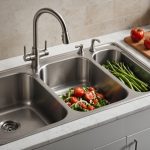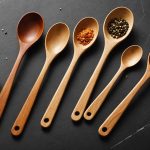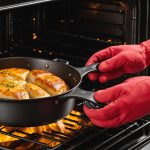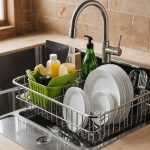Creating a kitchen that accommodates a diabetic diet can transform meal prep from a daunting task into an enjoyable experience. Thoughtful design features streamline cooking, promote healthy eating, and reduce the stress of managing dietary needs. By incorporating functional elements such as organized storage, easy-to-reach appliances, and optimal workspace, you can enhance your culinary environment. Explore the essential design features that support effortless meal preparation, making healthy cooking not just achievable but delightful.
Essential Counter Space
Creating a kitchen that works for you
This might interest you : Optimal Sink Solutions for a Lean Kitchen: Streamline Meal Cleanup and Minimize Food Temptation
Importance of Ample Counter Space
Having sufficient counter space is crucial for efficient meal preparation. It allows you to spread out ingredients, use multiple appliances, and maintain a clean and organized area. Without it, meal prep can become chaotic and frustrating. Consider the following benefits:
- Enhanced efficiency: More room to maneuver.
- Improved safety: Less clutter reduces accidents.
- Greater enjoyment: Cooking becomes less stressful.
Strategies for Optimizing Kitchen Layout
A well-thought-out kitchen layout can significantly improve accessibility and workflow. Here are some strategies:
Topic to read : Top Ergonomic Wooden Spoons for Healthy Low-Fat Cooking: Discover Your Perfect Kitchen Companion!
- Triangle setup: Position the sink, stove, and refrigerator in a triangle for easy movement.
- Vertical storage: Use wall-mounted racks to free up counter space.
- Island installation: Add an island for additional workspace if space permits.
Tips for Maintaining a Clutter-Free Workspace
Keeping your workspace tidy is essential for meal prep efficiency. Here are practical tips:
- Regularly clear surfaces: Remove unused items after each meal.
- Use organizers: Drawer dividers and shelf risers keep tools in order.
- Adopt minimalism: Only keep essential items on the counter.
By prioritizing counter space and optimizing your kitchen layout, you can enhance your cooking experience significantly.
Appliance Selection
Choosing the right tools for an efficient kitchen
Recommended Appliances for Healthy Cooking
Selecting the right kitchen appliances is vital for efficient and healthy meal preparation, especially in diabetic cooking. Essential appliances include:
- Blender: For smoothies and pureed soups.
- Instant Pot: Offers multiple cooking functions.
- Air Fryer: Allows for healthier frying with minimal oil.
These appliances not only support a healthy diet but also save time.
Features to Look for in Appliances
When choosing appliances, consider features that enhance efficiency and convenience:
- Programmable settings: Allow for precise cooking.
- Energy efficiency: Reduce electricity usage.
- Compact design: Save counter space.
Such features make cooking more manageable and enjoyable.
Smart Appliances for Diabetic Meal Prep
Smart appliances can significantly aid those focusing on diabetic cooking. Look for:
- Connected ovens: Offer recipe suggestions based on dietary needs.
- Smart scales: Provide nutritional information.
- Voice-controlled devices: Allow hands-free operation.
These innovations streamline meal prep, making it easier to maintain a healthy lifestyle. By integrating these kitchen appliances into your routine, you can enhance both the efficiency and quality of your cooking experience.
Storage Solutions
Efficient organization for a functional kitchen
Best Storage Options for Diabetic-Friendly Ingredients
Organizing your kitchen effectively is essential, especially for storing diabetic-friendly ingredients. Consider using airtight containers and labeling them for quick identification. This method not only preserves freshness but also ensures easy access. A pantry dedicated to diabetic staples like whole grains, nuts, and low-sugar snacks can enhance accessibility.
Organization Strategies for Easy Access to Tools and Ingredients
Efficient kitchen storage is about more than just space—it's about accessibility. Use drawer dividers to separate utensils and small gadgets, making them easy to find. A well-organized kitchen reduces meal prep time and stress, allowing you to focus on healthy cooking. Consider a lazy Susan for spices; it saves space and offers quick access.
Utilizing Vertical Space and Drawer Dividers for Efficiency
Maximize your kitchen's potential by utilizing vertical space. Install shelves above counters for items used less frequently. Wall-mounted racks can hold pots and pans, freeing up valuable counter space. Drawer dividers are another excellent tool for maintaining order. They help categorize items, ensuring everything has its place.
- Vertical storage: Shelves and racks
- Drawer dividers: Maintain order
- Airtight containers: Preserve freshness
Incorporating these storage solutions into your kitchen can improve functionality and make meal preparation a more enjoyable experience.
Food Preparation Tools
Essential equipment for efficient and healthy cooking
Essential Tools for Diabetic Meal Preparation
Having the right kitchen tools is crucial for effective diabetic meal prep. A well-equipped kitchen can simplify healthy cooking, ensuring you have everything needed to create nutritious meals. Key tools include:
- Quality knives: Essential for precise cutting and slicing.
- Cutting boards: Use separate boards for different food types to prevent cross-contamination.
- Measuring cups and spoons: Accurate measurements are vital for maintaining dietary balance.
Importance of Having the Right Knives and Cutting Boards
The right knives and cutting boards can transform your cooking experience. Sharp, reliable knives make cutting tasks easier and safer, reducing prep time. Meanwhile, sturdy cutting boards provide a stable surface, essential for efficient chopping. Consider investing in a set that includes:
- Chef's knife: Versatile and ideal for most tasks.
- Paring knife: Perfect for intricate cuts.
- Wooden cutting board: Durable and gentle on knives.
Recommended Gadgets for Simplifying Cooking Tasks
Incorporating gadgets into your meal prep equipment can enhance efficiency. Consider these additions:
- Mandoline slicer: Speeds up slicing.
- Spiralizer: Creates vegetable noodles, ideal for low-carb diets.
- Food processor: Versatile for chopping, slicing, and pureeing.
These kitchen tools not only streamline meal preparation but also support healthier cooking habits.
Lighting Considerations
Illuminating your kitchen for safety and efficiency
Significance of Proper Lighting in the Kitchen
Kitchen lighting plays a vital role in creating a safe and functional cooking environment. Adequate lighting ensures that you can see clearly while preparing meals, reducing the risk of accidents. It's essential for both task lighting and ambient illumination. Good lighting not only enhances visibility but also contributes to the overall ambiance and functionality of the kitchen.
Types of Lighting That Enhance Safety and Visibility
To optimize safety and visibility, it's crucial to incorporate a mix of lighting types. These include:
- Ambient lighting: Provides overall illumination.
- Task lighting: Focuses on specific areas like countertops and stoves.
- Accent lighting: Highlights features and adds depth.
Task lighting is particularly important for meal prep areas, ensuring you can see precisely what you're doing.
Tips for Incorporating Task Lighting for Meal Prep Areas
When planning your kitchen lighting, consider these tips for effective task lighting:
- Install under-cabinet lights to illuminate work surfaces.
- Use pendant lights over islands for focused illumination.
- Choose adjustable fixtures to direct light where needed.
By thoughtfully incorporating these elements, you can create a well-lit kitchen that enhances both safety and efficiency.
Workflow Optimization
Crafting a seamless meal preparation experience
Designing a Kitchen for a Smooth Cooking Workflow
A well-organized kitchen enhances the cooking process, ensuring meal prep workflow is efficient. Begin by arranging your space to facilitate movement between key areas. The kitchen triangle—linking the stove, sink, and refrigerator—remains a classic layout for optimal kitchen efficiency.
Steps to Create a Sequence for Meal Preparation
Establishing a sequence streamlines the meal preparation process. Consider these steps:
- Plan meals: Outline recipes and gather ingredients.
- Prep ingredients: Chop, measure, and organize before cooking.
- Cook efficiently: Follow recipes while multitasking when possible.
This approach minimizes downtime and enhances the cooking process.
Importance of Keeping Frequently Used Items Within Reach
Accessibility is crucial for kitchen efficiency. Store frequently used items like knives, cutting boards, and spices within arm's reach. This reduces unnecessary movement and saves time. A well-placed utensil holder or spice rack can significantly impact your meal prep workflow.
By optimizing your kitchen layout and organizing tools and ingredients strategically, you can transform your cooking experience, making it more enjoyable and efficient. This thoughtful design fosters a productive environment conducive to seamless meal preparation.
Visual Design and Aesthetics
Harmonizing beauty and practicality in your kitchen
Balancing Aesthetics with Functionality
Creating a kitchen design that balances aesthetic appeal with functional spaces is essential. A beautiful kitchen not only enhances your home's value but also makes meal preparation enjoyable. Consider using open shelving to display attractive dishware while maintaining easy access to everyday items. This approach ensures your kitchen remains both stylish and practical.
Color Schemes and Materials
Choosing the right color schemes and materials can transform your kitchen into a welcoming space. Light colors like whites and pastels can make small kitchens appear larger, while natural materials such as wood and stone add warmth and texture. Incorporating these elements can help create a harmonious environment conducive to efficient meal prep.
- Neutral tones: Timeless and versatile
- Bold accents: Add personality
- Durable materials: Ensure longevity
Examples of Visually Appealing Kitchens
Visually appealing kitchens are designed with both aesthetic appeal and functional spaces in mind. Consider a modern kitchen with sleek cabinetry and stainless steel appliances that support meal prep. Alternatively, a rustic kitchen with wooden beams and a farmhouse sink offers charm and practicality. These examples illustrate how thoughtful kitchen design can enhance both form and function.











